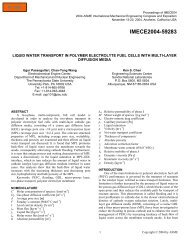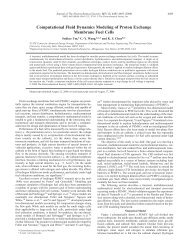DMFC stack.pdf - Electrochemical Engine Center
DMFC stack.pdf - Electrochemical Engine Center
DMFC stack.pdf - Electrochemical Engine Center
You also want an ePaper? Increase the reach of your titles
YUMPU automatically turns print PDFs into web optimized ePapers that Google loves.
1048<br />
G. Q. LU ET AL.<br />
6<br />
5<br />
4<br />
Air breathing 8-cell <strong>DMFC</strong> <strong>stack</strong><br />
Anode 4.8 mg/cm 2 Pt/Ru<br />
Cathode 0.9 mg/cm 2 Pt, Nafion ® 112<br />
Single cell area: 5cm 2<br />
2M methanol, ξ a =2@150mA/cm 2<br />
Room temperature<br />
2000<br />
1600<br />
Voltage (V)<br />
3<br />
1200<br />
800<br />
Power (mW)<br />
2<br />
1<br />
Voltage<br />
Power<br />
400<br />
0<br />
0<br />
0 200 400 600 800<br />
Current (mA)<br />
Figure 8. Polarization and power curves of the 8-cell air-breathing <strong>DMFC</strong> <strong>stack</strong>.<br />
current densities for different cells reached a reasonably narrow range. Theoretically, the<br />
methanol solution should flow through the 8 individual cells uniformly, according to the<br />
uniform flow path design shown in Figure 1. However, pressure loss for the flow through each<br />
cell might fluctuate dynamically because of non-uniform distribution of the carbon dioxide gas<br />
bubbles produced in the anodes, causing the flow rate through each cell to vary. Figure 5 shows<br />
the non-uniform distribution of CO 2 bubbles in the anode using the transparent <strong>DMFC</strong> (Lu and<br />
Wang, 2004). In the worst case, large gas bubbles might block an entire flow channel,<br />
particularly a narrow one. Therefore, proper gas management in the anode is critical for<br />
uniform methanol transport in <strong>DMFC</strong> <strong>stack</strong>s with parallel flow field.<br />
Oxygen transport limitation: To evaluate whether the air breathing <strong>DMFC</strong> suffers from<br />
the mass transport limitation, we measured the limiting current density. Figure 6 shows<br />
the polarization curve of cell #1 supplied with 2 M methanol solution. Figure 7 shows the<br />
polarization curve of cell #1 using fully humidified hydrogen under a very large flow rate. The<br />
cell temperature was around 308C due to natural cooling for both cases given in Figures 6 and 7.<br />
The average limiting current density for 8 individual cells using 2 M methanol is 167 mA cm 2 ,<br />
while that using humidified hydrogen is 773 mA cm 2 . Since hydrogen is much more reactive<br />
than methanol with minimum activation loss at the anode, and since the large hydrogen flow<br />
rate used in these experiments guarantees no mass transport loss at the anode, the limiting<br />
current density obtained with supply of humidified hydrogen comes primarily from the mass<br />
transport limitation at the air-breathing cathode.<br />
Copyright # 2005 John Wiley & Sons, Ltd. Int. J. Energy Res. 2005; 29:1041–1050




